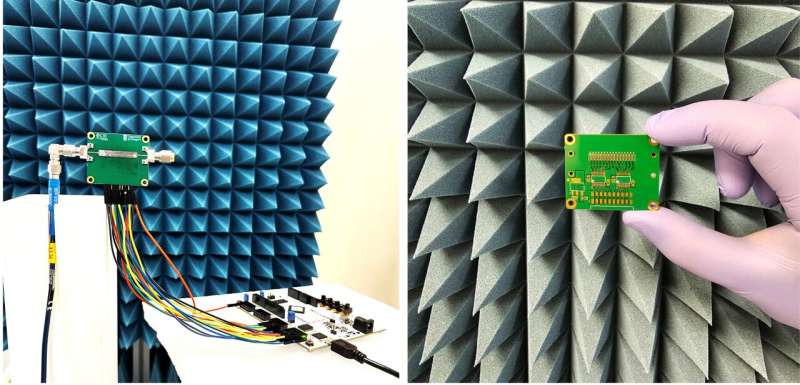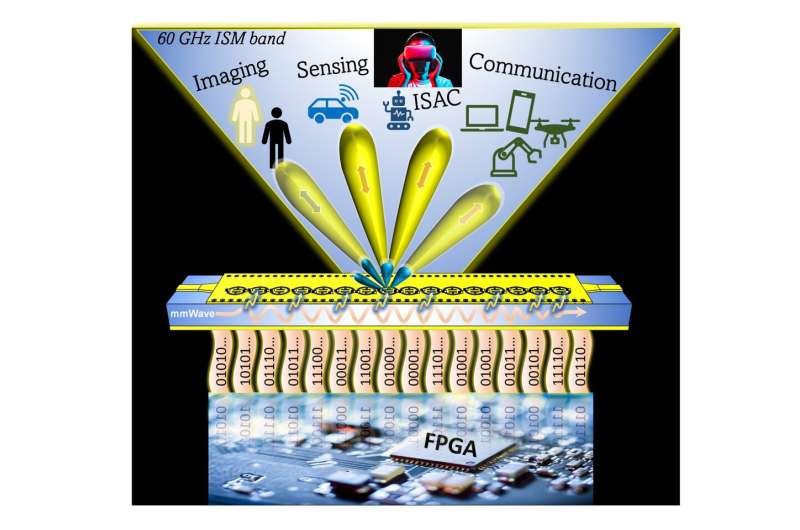This article has been reviewed according to Science X's editorial process and policies. Editors have highlighted the following attributes while ensuring the content's credibility:
fact-checked
trusted source
proofread
Metasurface antenna could enable future 6G communications networks

A team led by researchers from the University of Glasgow has developed an innovative wireless communications antenna that combines the unique properties of metamaterials with sophisticated signal processing to deliver a new peak of performance.
In a paper published in the IEEE Open Journal of Antennas and Propagation, titled "60 GHz Programmable Dynamic Metasurface Antenna (DMA) for Next-Generation Communication, Sensing, and Imaging Applications: From Concept to Prototype," the researchers showcase their development of a prototype digitally coded dynamic metasurface antenna, or DMA, controlled through high-speed field-programmable gate array (FPGA).
Their DMA is the first in the world designed and demonstrated at the operating frequency of 60 GHz millimeter-wave (mmWave) band—the portion of the spectrum reserved by international law for use in industrial, scientific, and medical (ISM) applications.
The antenna's ability to operate in the higher mmWave band could enable it to become a key piece of hardware in the still-developing field of advanced beamforming metasurface antennas.
It could help future 6G networks deliver ultra-fast data transfer with high reliability, ensuring high-quality service and seamless connectivity, and enabling new applications in communication, sensing, and imaging.
The DMA's high-frequency operation is made possible by specially designed metamaterials—structures that have been carefully engineered to maximize their ability to interact with electromagnetic waves in ways that are impossible in naturally occurring materials.
The DMA uses specially designed, fully tunable metamaterial elements that have been carefully engineered to manipulate electromagnetic waves through software control, creating an advanced class of leaky-wave antennas capable of high-frequency reconfigurable operation.

The matchbook-sized prototype uses high-speed interconnects with simultaneous parallel control of individual metamaterial elements through FPGA programming. The DMA can shape its communications beams and create multiple beams at once, switching in nanoseconds to ensure network coverage remains stable.
Professor Qammer H. Abbasi, co-director of the University of Glasgow's Communications, Sensing and Imaging Hub, is one of the paper's lead authors. He said, "This meticulously designed prototype is a very exciting development in the field of next-generation adaptive antennas, which leaps beyond previous cutting-edge developments in reconfigurable programmable antennas.
"In recent years, DMAs have been demonstrated by other researchers around the world in microwave bands, but our prototype pushes the technology much further, into the higher mmWave band of 60 GHz. That makes it a potentially very valuable stepping stone towards new use cases of 6G technology and could pave the way for even higher-frequency operation in the terahertz range."
The capabilities of the DMA design could find use in patient monitoring and care, where it could help directly monitor patients' vital signs and keep track of their movements.
It could also enable improved integrated sensing and communications devices for use in high-resolution radar and to help autonomous vehicles like self-driving cars and drones safely find their way around on the roads and in the air.
The improved speed of data transfer could even help create holographic imaging, allowing convincing 3D models of people and objects to be projected anywhere in the world in real time.
Dr. Masood Ur Rehman, from the University of Glasgow, James Watt School of Engineering, who led the antenna development, said, "6G has the potential to deliver transformative benefits across society. Our high-frequency intelligent and highly adaptive antenna design could be one of the technological foundation stones of the next generation of mmWave reconfigurable antennas. The programmable beam control and beam-shaping of the DMA could help in fine-grained mmWave holographic imaging as well as next-generation near-field communication, beam focusing, and wireless power transfer.
"We'll work toward the extension of this design in the near future to offer more flexible and versatile antenna performance and continue to play our part to meet the needs of our increasingly connected smart world."
More information: Abdul Jabbar et al, 60 GHz Programmable Dynamic Metasurface Antenna (DMA) for Next-Generation Communication, Sensing, and Imaging Applications: From Concept to Prototype, IEEE Open Journal of Antennas and Propagation (2024). DOI: 10.1109/OJAP.2024.3386452



















